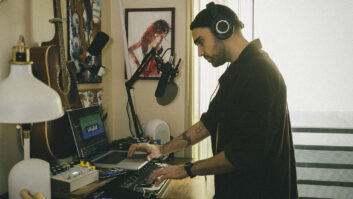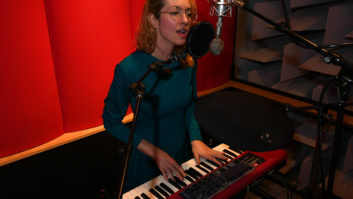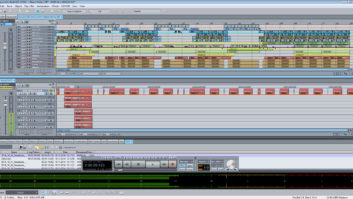Singapore is the quintessence of modern Asia: a gleaming forest of glass-and-steel highrises towering over the two- and three-story shop buildings that still make up the majority of this city’s commercial infrastructure. Inside two of those low-rises, the evolution of Asia’s audio post-production business can be seen.
OPUZ first opened in 1995, a two-room studio intended as the tool for a trio of remixers/engineers/musicians whose local reputation for contributing to regional music hits had pushed them into audio post, as well. Both Paul G. Tan and his brother, Paul T., had learned the DJ trade in Singapore clubs, collaborating with keyboardist/programmer Case Woo. Paul G. attended the University of Oregon and later entered the audio recording and production program at Loyola Marymount University in Southern California, picking up some real-world experience at Skip Saylor Studios in Los Angeles. He returned to Singapore in 1990 and, with his brother and Woo, began a remixing career.
OPUZ followed five years later, on the second floor of a shop building on Circular Quay, alongside one of Singapore’s canals. It was a propitious point in time. Singapore’s government was fostering local commercial arts ventures, including music and film; the Singapore outposts of global advertising companies, such as Leo Burnett, were becoming more active as Asia’s economic “tigers” — particularly Singapore — were flexing their financial muscles; and U.S. cable companies, such as The Discovery Channel and HBO, were targeting Asia, as well, making Singapore their regional base.
“Everything seemed to come together at the right time,” Paul G. Tan says of that moment. “But if I’d learned anything from working in the States, it was that in post, it was results that counted, that things had to be done as perfectly as possible and the client had to be catered to.”
Sam Toyashima was contacted to design the original facility, which has two control rooms facing onto a shared recording space. The spaces are relatively small, using a lot of trapping to moderate the acoustics, and were intended to accommodate both music and post, with an accent on MIDI gear in the smaller of the two control rooms. Music recording and mixing, however, quickly took a backseat to post as Singapore’s studio business, like that of the rest of the world, began to feel the effects of project studios. “They call them ‘jam’ studios here,” Tan explains. “And some of them go for as little as $18 [Singapore, about U.S. $10] an hour. It was no business to be in anymore.”
The post business, though, was poised to take off, and the facility was positioned to ride that wave, with a strategy of implementing leading-edge technologies at the time, such as APT and CDQ ISDN capability. Local ad agencies appreciated the link, allowing them to bring in voices from Sydney to Chicago. The strategy worked, and the facility picked up a steady stream of regional and international commercial awards, which now fill trophy cases in the foyer of the first facility. There was also some ADR work for films coming in from the U.S., including Miramax’s That’s the Way I Like It.
BUILT FOR POST
By 2000, that first facility’s limitations had become clear. It would be augmented that year with a new set of studios in a nearby building. Toyashima also designed this new facility, but where the first design had been quite utilitarian, in this instance the Tans stressed the need to create an aesthetic that would appeal to a global advertising industry. In fact, the second studio facility would be instantly familiar to anyone who frequents the post-production lofts of London’s SoHo district: electric colors, sleek lines, and lots of hardwood floors and frosted glass.
While both studio facilities remain in operation, the new facility was an evolutionary extension of the first. The original building uses a Soundtracs Topaz in the larger of the two control rooms, and a combination of a Yamaha 02R and 01V digital mixers in the other. The two new studios are completely digital, with the main room sporting a Soundtracs DS-3 digital console and the second a Mackie D8B mixer. All studios in the building are tielined, using both RJ45 and AES/EBU protocol, as well as analog mic lines. All studios use Digidesign Pro Tools as the main recording medium, and all those systems are networked via Ethernet.
Though the newer studios are significantly larger, the acoustical designs are similar to the original Toyashima plans at the first facility, with gentle compression ceilings and extensive bass trapping. The largest control room is fitted for 5.1 surround mixing and features what has to be the most unique rear-channel speaker setup yet devised. The Genelec 1030 monitors are suspended, attached to sliding poles that drop from the ceiling with the use of a clever counterweight device that Tan says took the construction crew three months to perfect, getting the suspension mechanism to balance just right while keeping the 110° angle constant. The result is ingenious, and many first-time visitors to the studio — including this writer — spend the first five minutes pushing and pulling the monitors up and down and marveling at them as though they were a clockwork from a Medieval church tower.
A BASIS FOR BUSINESS
As one of Asia’s main commercial hubs, Singapore has a deeply entrenched advertising industry. With more than 3 billion potential consumers throughout the continent, and the impending entry of China into the World Trade Organization, the role of advertising in projecting brands into this massive market can’t be understated. That intensive ad blitz goes hand in hand with the proliferation of new video outlets, both terrestrial broadcasting and cable. Tan set OPUZ’s sights on advertising from the beginning, but also cultivated relationships with the nascent cable industry in Singapore.
“The advertising agencies have always had the budgets, but even though cable didn’t have the same level of budgeting, I felt that they would be good long-term prospects,” he explains of his strategic thinking.
It paid off, particularly with OPUZ’s ISDN services. Shiamala Kathirvayloo, a senior producer for the Animal Planet Asia cable channel, a joint venture between The Discovery Channel and the BBC, which launched in October of last year, says that OPUZ’s ISDN capability and its expertise has been critical in the channel’s expansion. Despite the budget pressures endemic to cable production everywhere, she’s been loyal to OPUZ for that and other audio post services, such as scoring and sound effects, and is willing to pay a slight rate premium to feel confident about meeting deadlines, getting reliable creative input and maintaining quality.
“The budget issues are always there,” she explains. “But we’ve got to be competitive — our biggest competitor is the National Geographic channel, and they work hard at it, too. So I need to be able to know that I can juggle multiple scripts and have these guys working on the post without me always there for each project and confident that it’s going to sound good and be what I want it to be. In that regard, there’s really no difference between Singapore or New York, from the point of view of a producer.”
One of those projects, a promo for World Animal Day, won Best Sound Mix at the New York Festivals Awards (formerly the New York Media Festival) earlier this year. “It had a lot of sounds, and it was also fun to do,” she recalls. “We used a lot of library animal sounds, but we also had Paul out there on the microphone making up some of his own sounds. That’s the kind of creativity I can appreciate.”
ISDN is virtually a 24/7 proposition when you’re 13 hours ahead of the U.S. East Coast. During one dinner, around 10:30 p.m., at a restaurant on Singapore’s bustling Clark Quay, Tan excused himself to walk over to the studio to check on the progress of a remote voice-over session being done with voice talent in a Detroit studio.
It’s not as though there’s a shortage of English speakers in Singapore — English is the lingua franca of this multiracial, multicultural country, and it’s mandatory for school children from grade school onward. Plus, like Hong Kong, the city teems with American, Australian and UK expats working in the financial and tech sectors. But accent is everything. Kathirvayloo notes that Australian viewers naturally respond to Australian accents, and that goes for the dozens of other regional and national linguistic variations that Asian broadcasters have to address.
Animal Planet, like other cable operations, has to do multiple feeds to address the myriad languages and cultures in the region. The Discovery Channel already does feeds in English (American and Australian, considered quite distinct from one another), Mandarin, Hindi, Thai, Korean and Japanese. Plus, Shiamala adds, certain channels need obviously American accents even in Asia to maintain brand identity. “I used to work at HBO here, and that is perceived as an American entertainment product,” she says. “So you definitely need American voice talent, sometimes a very specific person. ISDN is the only way to do that.”
OPUZ has also increased its efforts to seek new markets, particularly Internet-based ones. For instance, the studio now does the file-format conversions and some of the mastering for Planet MG.com, a fast-growing Asian music portal.
ISDN, digital consoles, hard disk recording and other technology enhancements, plus a heightened sense of customer service, underscore how much Southeast Asia’s audio post industry has progressed in a relatively short time. Five years ago, when Synchrosound in neighboring Kuala Lumpur opened, the facility made a point of recruiting American and UK engineers, reflecting the shallowness of the technological talent pool in the region at the time and to reassure clients that the necessary technical prowess would be there. Tan, on the other hand, says that the pool has grown to the point where a certain amount of headhunting now goes on for engineering talent, though he prefers to develop his engineering crew (six staffers, three of whom, including him, are engineers) from within.
OPUZ’s experience also indicates that issues facing audio post facilities, such as the proliferation of project studios and the need to diversify services and client bases, are universal. That will only become more true as media companies, such as the BBC, AOL/Time Warner, Star Network and others, continue to become increasingly global in reach, yet need locally based post services.
But what sets Asia apart is the growth potential implicit in the region. Rapidly increasing affluence in China, Singapore, India and other countries has made the area a prime target for media and advertising. “And those companies coming here from the U.S. and Europe are already very savvy and sophisticated in terms of audio,” says Tan. “What we’re doing is giving them a technology infrastructure that’s just as sophisticated, as well as one that understands the cultures of the areas they’re working in.”







